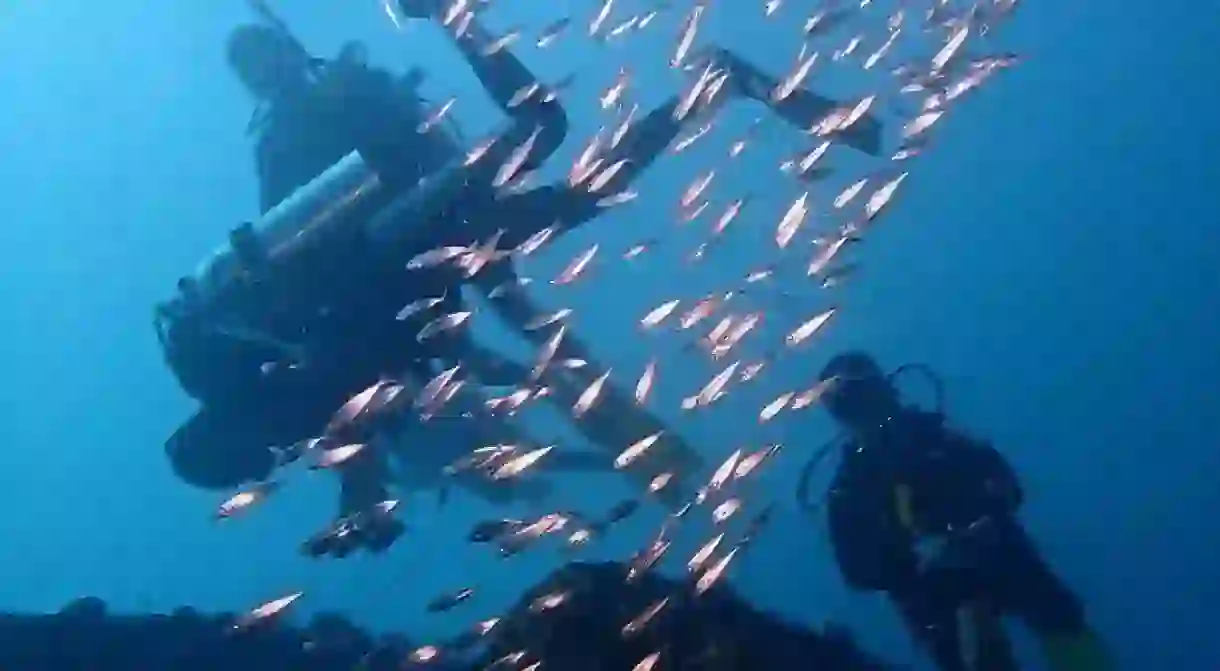A Guide to the Best Scuba Diving Around Cartagena

With clear waters, white beaches and huge coral reefs, the Caribbean coast of Colombia has premier conditions for a scuba adventure.
Just a short boat ride from Cartagena, the gem of Colombia’s Caribbean, spectacular dive sites can be enjoyed as part of a trip to the city, or as a trip in themselves. Divers can swim under the crystalline surface for a chance to see sharks, rays and huge spider crabs on the reef, and retreat to the stunning tropical luxury of one of Cartagena’s palm-dotted islands when they’re done.
How to get yourself submerged
Amateur divers can start from zero in Cartagena – with warm temperatures and easy dives nearby, it’s the perfect place to get an Open Water Certification. There are also spots to work on advanced qualifications for more experienced divers. Cartagena has a number of dive centers to make this happen.

Between the Old City and Bocagrande, a peninsula to the west of the walled city known for its towering glass skyscrapers, visitors shouldn’t have too much difficulty finding a divemaster to show them the ropes.
What you’ll see
The coastline is flanked by a huge coral reef, which provides an amazing habitat for all kinds of sea life. The coast also boasts a few sunken boats that provide a scenic environment for more advanced divers. For something truly unique, there’s an underwater art museum just off the coast, with subaquatic sculptures by Germán Botero, a local artist.
The reef is also home to all kinds of amazing wildlife, from the coral itself to the fish who feed on coral – and the creatures that feed on the fish. The reef hosts around 280 species of tropical fish, including angelfish, butterflyfish, parrotfish and pufferfish. Around the coral, divers may also encounter reef sharks, nurse sharks, stingrays, octopuses, seahorses and moray eels. For a better shot of seeing crabs, octopuses and lobsters, head out onto the water after sunset for a night dive.

Particularly spectacular in this area are the massive corals, including brain and star coral, which grow to diameters of nearly 10 feet (3 meters). These and branch coral colonies create incredible landscapes to explore and habitats for native fish.
The waters around Cartagena are typically around 82F (28C), and visibility is good – between 16.4 and 131 feet (5 and 40 meters) – with currents that range between light and moderate, depending on the weather and time of year.

Recommended Cartagena dive sites
The Pedro de Heredia and Salmedina shipwrecks
Full of history and spectacular underwater life, the remains of the Pedro de Heredia are perched on a sandbank among the corals that have colonized it. More experienced divers can swim through the wreck using guide cords. It’s only ten minutes north of Cartagena, and depths range between 40 and 120 feet (12 and 36.5 meters). Divers should be on the lookout for fire coral, a type of uncommon false coral that takes on dizzying shapes and striking colors.

Salmedina is a coral formation of a series of vast undersea plateaus and cliffs. This site, which is right offshore, is especially popular due to its two sunken ships at the base of a lighthouse. It’s 20 minutes east of Cartagena and reaches depths between 20 and 120 feet (6 and 36.5 meters).
Underwater art museum
Near to Isla Barú, one of the bigger islands close to Cartagena, is something truly unique: a museum at the bottom of the sea. Divers can float between the sculptures by Colombian artist Germán Botero. The sculptures are themed around environmentalism, and are known as The Garden of Jellyfish. Besides being aesthetically striking, the sculptures also double as an artificial reef and are slowly being colonized by coral and other aquatic life.
Montañita (Little Mountain)
Montañita is an underwater rock structure covered in soft coral and vast barrel sponges. Dives to the lower part of the mountain will bring divers face-to-face with a fair amount of wildlife, including groupers and jackfish.
Imelda
Located about 13 miles (21 kilometers) south of Cartagena, Imelda is an oceanic shelf covered by a huge range of coral and sponges. Reaching depths between 55 and 120 feet (16.8 and 36.5 meters), divers will be accompanied by a variety of fish like sergeant fish and mackerel.
San Bernardo Archipelago and Taganga
A bit further afield is the San Bernardo Archipelago, which is about a two-hour boat ride from Cartagena. Another more distant diving location is Taganga, near Santa Marta. The popular beach town is known to be one of the most economical places to get scuba certified in the Americas.
Tips for responsible diving
Watch your floatation; the reef can get pretty shallow around Cartagena. This is critical to be aware of so that divers can watch their flippers to make sure they don’t knock the reef. Hitting the reef, or the fish that call the reef home, can cause damage and disrupt eating or reproductive cycles. A good motto for diving is “take only photos, leave only bubbles.” Removing even a shell can throw off this finely tuned ecosystem.













